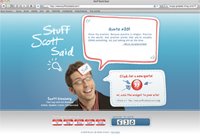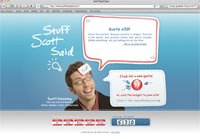 Today we’re going to continue exploring practices to help you become known as the most approachable person in your organization. (If you haven’t read Part 1 of this series, you can do so here.)
Today we’re going to continue exploring practices to help you become known as the most approachable person in your organization. (If you haven’t read Part 1 of this series, you can do so here.)
Whether you’re an office professional, middle manager, C-level executive or part of the overnight cleaning crew, executing these strategies will accomplish three goals:
(1) Boost the net worth of your human capital, (2) Attract MORE attention, MORE people and MORE opportunities into your world, and (3) Reduce the possibility that your company will kick your butt to the curb in this crappy economy.
1. Boost your communication self-awareness. Sure, YOU think you’re approachable. And maybe you are. But it doesn’t matter what you think. It matters what other people remember. It matters what other people feel. And it matters what other people tell their friends, blog and tweet about. So, view performance feedback as a learning opportunity to find out where you suck.
Otherwise you’ll be the last one to find out how you’re doing. Otherwise you’ll end up like Michael Scott on The Office, a branch manager who is completely unaware of how moronic he really is.
Like the time he hosted a dinner party for his employees and referred to the wine as having “An oaky afterbirth.” Good lord. No self-awareness whatsoever. Are you approachable, but not perceived as being approachable? Are you approachable, but not remembered as being approachable? And when you meet people, is your first thought about what they think of you or how you can make them more comfortable?
2. Choose to attend differently to people. Not “type.” Not “deal with.” Not “tolerate.” Not “manipulate.” Attend. This word comes from the French atendre, which means, “to direct one’s mind or energies.” Wow. Sounds so much friendlier. More approachable. More relaxing. Less judgmental and suspicious, too.
TRY THIS: Dance in the moment. Ask yourself how you could attend differently to this person. Stop putting people in predictable little boxes with handy little labels that read, “introvert” or “right brained” or “potential serial killer.”
Get to know people for who they really are; not what others have haphazardly labeled them as. You never know. They might turn out to be pretty cool after all. Serial killers have feelings too, you know. Does this represent a temporary state of mind or a permanent state of being? What character qualities do I admire in them? And what is the hidden treasure inside this person that maybe others don’t see?
3. Learn to be open to people you don’t approve of. I’m not accusing you of being a finger-wagging monument of judgment. Still, each of us needs to confront our prejudices and honestly ask, “What type of people am I offended by?” Remember: The awareness of your intolerance is the first step to overcoming it.
My challenge to you is to learn how to play two games: (1) “Let’s See How Many People I Can Talk To Today That I Don’t Approve Of,” and (2) “How Much Would I Have To Learn About These People To Reverse My Disapproval Of Them?” Sure, it sounds kind of silly. But that’s the point.
This reminds me of Herbert Leff’s book, Playful Perception; where he suggests you regard whatever you’re doing as a game. It adds a childlike sense of playfulness and adventure to whatever you’re engaged in. What invisible walls have you built? What is preventing you from, or making it hard for you to be open TO this person? What values do you hold that could influence your response to this person?
4. Expand your openness to learning from others. Here’s a cool little routine I’ve been practicing for many years. Not only does it demonstrate openness to learning form others; it also makes people feel essential. Not just important and valued – essential.
After a lunch conversation, engaging phone call or even a round of golf with a customer, employee, whatever, send that person an email with the subject line, “11 Things I Learned from You Today.” Recap some of the best “keepers” from your conversation.
It shows you listened, it shows you care and it shows you’re approachable enough to learn from anybody, anytime, anywhere. How vulnerable are YOU willing to be? How, specifically, do show others that they’ve been listened to? And what would happen to your storehouse of wisdom if you allowed everyone you came in contact with to mentor you?
5. Allow people to experience that they can change your mind. Defensiveness is defined as “the attempt to prevent new ideas from entering into your world.” This, of course, is dangerous, as you aren’t as smart as you think you is.
My suggestion is to (yikes!) practice a little vulnerability. Use Phrases That Payses like, “I can’t believe that never occurred to me,” “Actually, I take back what I said,” and “You know, after thinking about it, you’ve convinced me to change my position on that issue!”
REMEMBER: Resist putting yourself into a position where you think you know all the answers. You need to release your current knowledge to take in new information.
The cool part is, when people see that they can change your mind, they’ll become more likely to listen to you and, as a result, more open to changing THEIR minds. How certain are you? Which of your ideas are guarded by arrogance? And how would you treat people if you weren’t working so hard to prove them wrong?
LET ME ASK YA THIS…
How will you become the most approachable employee in your organization?
LET ME SUGGEST THIS…
For the list called, “26 Rapid-Fire Strategies for Turning Approachability into PROFIT-ability,” send an email to me, and I’ll send you the list for free!
* * * *
Scott Ginsberg
That Guy with the Nametag
Author, Speaker, Coach, Entrepreneur
[email protected]
 Who’s quoting YOU?
Who’s quoting YOU?
Check out Scott’s Online Quotation Database for a bite-sized education on making a name for yourself!

 In this multi-post series, we’re going to explore daily practices to help you become known as the most approachable person in your organization.
In this multi-post series, we’re going to explore daily practices to help you become known as the most approachable person in your organization. Who’s quoting YOU?
Who’s quoting YOU?